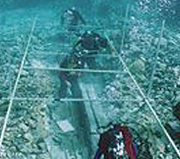Corrosion Analysis
The process of taking marine corrosion measurement showing the use of an underwater pneumatic drill, and the deployment of the underwater pH probe and corrometer (all images courtesy Program in Maritime Studies, ECU).
Several techniques are needed to assess the stability of the iron and steel shipwrecks in St. George's Harbor. For each wreck, structurally sound points along the hull must first be chosen for testing. A pneumatic drill may then be used to create a hole, cutting through the corrosion product layers and exposing bare metal. A pH probe is quickly inserted to check the acidity of the seawater against the freshly exposed metal, which is an indicator of the level of corrosion occurring in that part of the wreck. Next, a corrosion potential probe is used to measure the voltage difference between the ocean and the wreck. A high difference indicates that the corrosion on site is occurring rapidly. Temperature, salinity, and dissolved oxygen readings are taken so that scientists can study how environmental variables affect wreck stability. Finally, the drill hole is filled with a waterproof epoxy to impede further corrosion of the newly-exposed metal.
Previous

